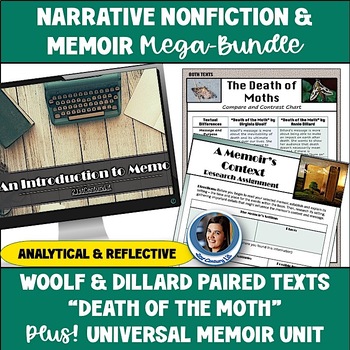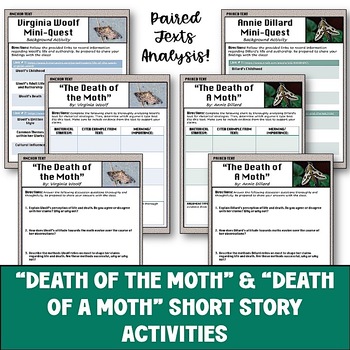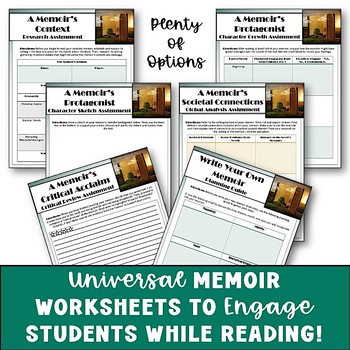Narrative Nonfiction & Memoir Unit ELA Short Story & Memoir Analysis Activities
- Zip
Products in this Bundle (5)
Also included in
- Looking for a comprehensive yearlong bundle of resources for AP Language and Composition? This full year AP Lang curriculum package contains 36 weeks of outlined instruction focused on rhetorical analysis, argumentative techniques, synthesizing information, historical connections, and extensive examPrice $134.99Original Price $228.40Save $93.41
- If you're like me, you are teaching two or more different high school English preps and are in need of multi-faceted resources that can solve your preparatory burdens! Fortunately, this jammed-packed value bundle, offered at over a 35% discount, contains enough materials for multiple ELA curriculumPrice $229.99Original Price $362.69Save $132.70
Description
Together, these diverse materials create a 5-6 week unit that thoroughly covers the memoir and narrative nonfiction genre. First, students will work closely with two iconic paired short texts - "Death of the Moth" by Virginia Woolf and "Death of A Moth" by Annie Dillard. Not only will they analyze each story in length, but they will discuss their similarities and differences - which obviously go much deeper than their titles! Then, they can dive into any full-length memoir of your choosing, using the universal materials provided to guide their reading/comprehension and assess their deeper understanding of the texts.
Materials Included:
Woolf & Dillard Paired Texts Nonfiction Unit: Death of The Moth, Death of A Moth
Virginia Woolf’s “Death of the Moth” Materials
- Mini Web Quest on Virginia Woolf – to help students gather important contextualized background information
- During Reading Note-Taking Worksheet– to guide student reading and interaction with Woolf’s text for the first time
- Rhetorical Analysis and Argument Type Chart – to prompt student engagement and analysis with Woolf’s text on a deeper level
- Discussion Questions – to allow students to reflect on the important meanings of Woolf’s text in a scholarly setting
- 15 Question Multiple-Choice quiz – with a focus on rhetorical analysis and words-in-context questions
- Detailed Answer Keys!
Annie Dillard’s “Death of A Moth” Materials
- Mini Web Quest on Annie Dillard – to help students gather important contextualized background information
- During Reading Note-Taking Worksheet– to guide student reading and interaction with Dillard’s text for the first time
- Rhetorical Analysis and Argument Type Chart – to prompt student engagement and analysis with Dillard’s text on a deeper level
- Discussion Questions – to allow students to reflect on the important meanings of Dillard’s text in a scholarly setting
- 12 Question Multiple-Choice quiz – with a focus on rhetorical analysis and words-in-context questions
- Detailed Answer Keys!
Paired Materials, Extension Activity, and Project
- Compare and Contrast Chart – to help students analyze the similarities and differences between the two texts
- Optional Extension AP Language and Composition FRQ – to help potential or current AP students with the essay portion of their exam
- “Narrative Nonfiction” Writing Project – to engage students in composing their own nonfiction piece inspired by nature.
- Outlined Requirements
- Detailed Planning Guide
- Comprehensive Scoring Rubric
Introduction to Memoir Mini-Lesson: Editable PPT Presentation with Quiz & Key!
- Editable PowerPoint Presentation - you can change/alter any slide and can add more or take away slides to fit the purpose of your lesson
- Timeline and Brainstorming Memoir Activity - to help students develop their own memoir short story idea
- Multiple-Choice and True/False Quiz - to assess students on the presentation materials
- Answer Key for the Quiz Included!
Memoir Analysis Worksheets: Activities, Assignments, & Project for ANY Memoir!
- “A Memoir’s Context” Research Assignment – to have students research the setting of their memoir and any important events, trends, or ideologies that might impact their memoir’s message in pivotal ways
- “A Memoir’s Language & Style” Annotation Assignment – to prompt students to annotate their memoir’s pages, choosing strong examples to record in chart format throughout their reading
- “A Memoir’s Protagonist” Character Sketch Assignment – to have students creatively depict the author, using details from the text to support their artistic choices.
- “A Memoir’s Protagonist” Character Growth Assignment – for those who may be less artistically inclined, another chance to analyze the protagonist and their growth throughout the book
- “A Memoir’s Societal Connections” Global Analysis Assignment – to have students make societal connections to the events and characters within their memoir
- “A Memoir’s Motifs and Themes” Post Analysis Assignment – to help students analyze the deeper implications of their memoir’s message
- “A Memoir’s Symbolic Ties” Post Analysis Assignment – to help students analyze the deeper implications of their memoir’s message
- “A Memoir’s Critical Acclaim” Written Review Assignment – to prompt students to rate their novel and then explain their rating with evidence from the text
- “Write Your Own Memoir” Project, with Planning Guide, Project Requirements, and Rubric – to guide students through the process of memoir writing
Memoir Nonfiction Article Pairings Chart: 8 Articles with Links for ANY Memoir!
- Lesson plans with detailed procedures and teacher’s notes included
- A “Non-fiction Text Pairings Chart” for students, complete with 8 different non-fiction connections, links, and instructions for how students should focus their analyses. (Offered in both PDF and Editable Word formats)
- A Detailed Teacher’s Guide to help you understand how each article connects to a memoir unit
- Focus questions for each article to prompt student analysis and discussion (over 20 total!)
Memoir Presentation Project: Lesson, Requirements, & Rubric for Any Memoir!
- A thorough Teacher's File - includes suggested implementation, procedures, and possible student feedback/discussion options
- Detailed Project Requirements (offered in both PDF and Editable Word Formats) - to outline clear student expectations
- Presentation Tips - to maximize student success
- Scoring Rubric (offered in both PDF and Editable Word Formats) - to ease your grading burden and facilitate meaningful student feedback
- A Sample Presentation for First They Killed My Father by Loung Ung - to offer students with an example before starting their own project
Keywords: memoir, narrative nonfiction, non-fiction, autobiographical writing, creative nonfiction, The Glass Castle, Angela's Ashes, The Liars Club, Running with Scissors, Me Talk Pretty One Day, I am Malala, Memoirs of A Boy Soldier, First They Killed My Father, The Color of Water, Memoirs of A Geisha, AP Language, AP Composition, AP Lang, AP Comp, juniors, 11th grade, literature circles, memoir circles, independent study, novel study, memoir short stories, short story, comparing two mediums, rhetorical strategies, narrative non-fiction, personal narrative, autobiography, biography, Virginia Woolf, Annie Dillard







